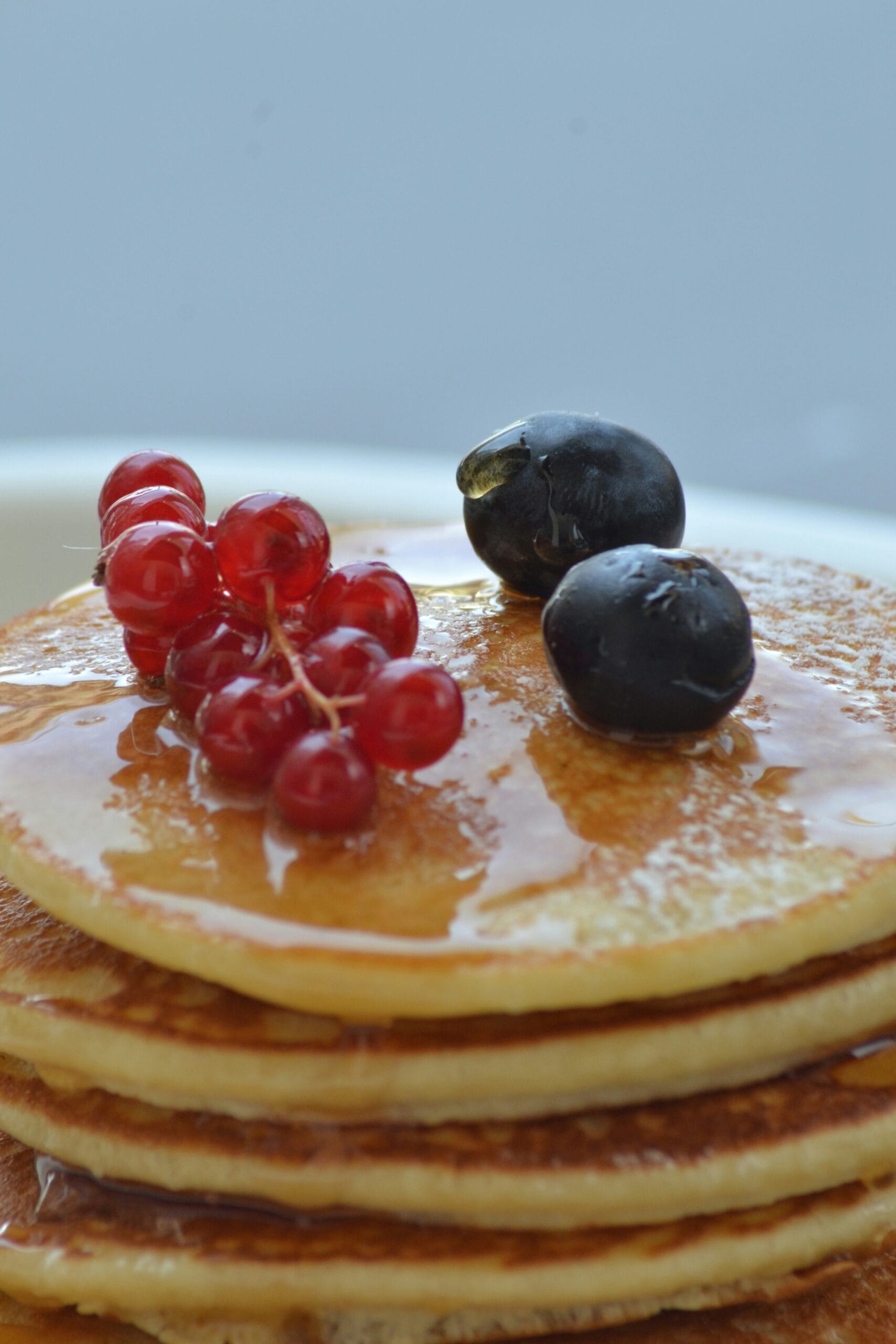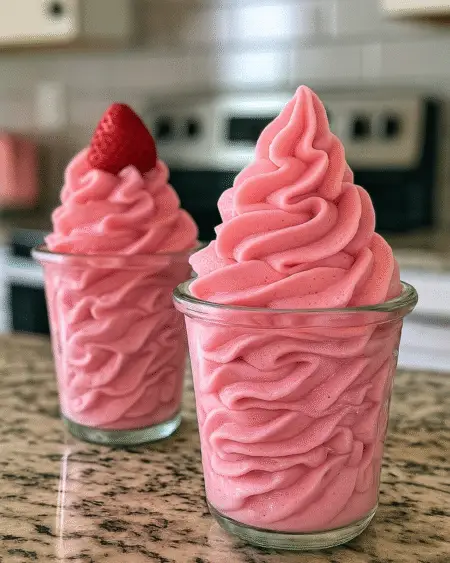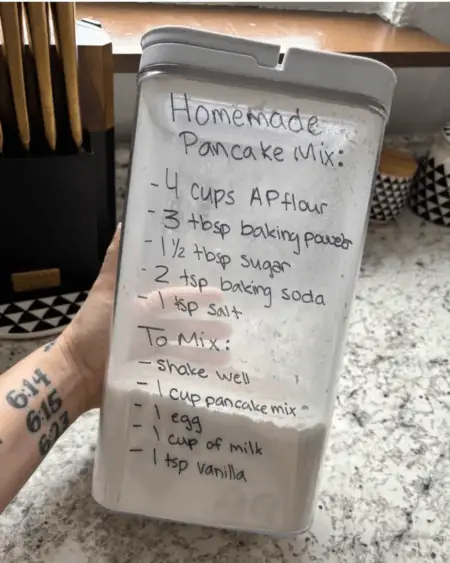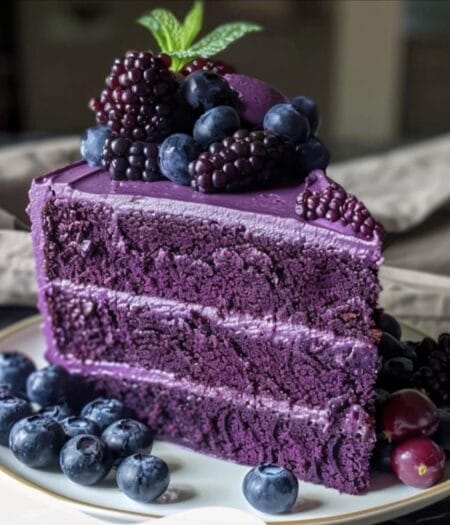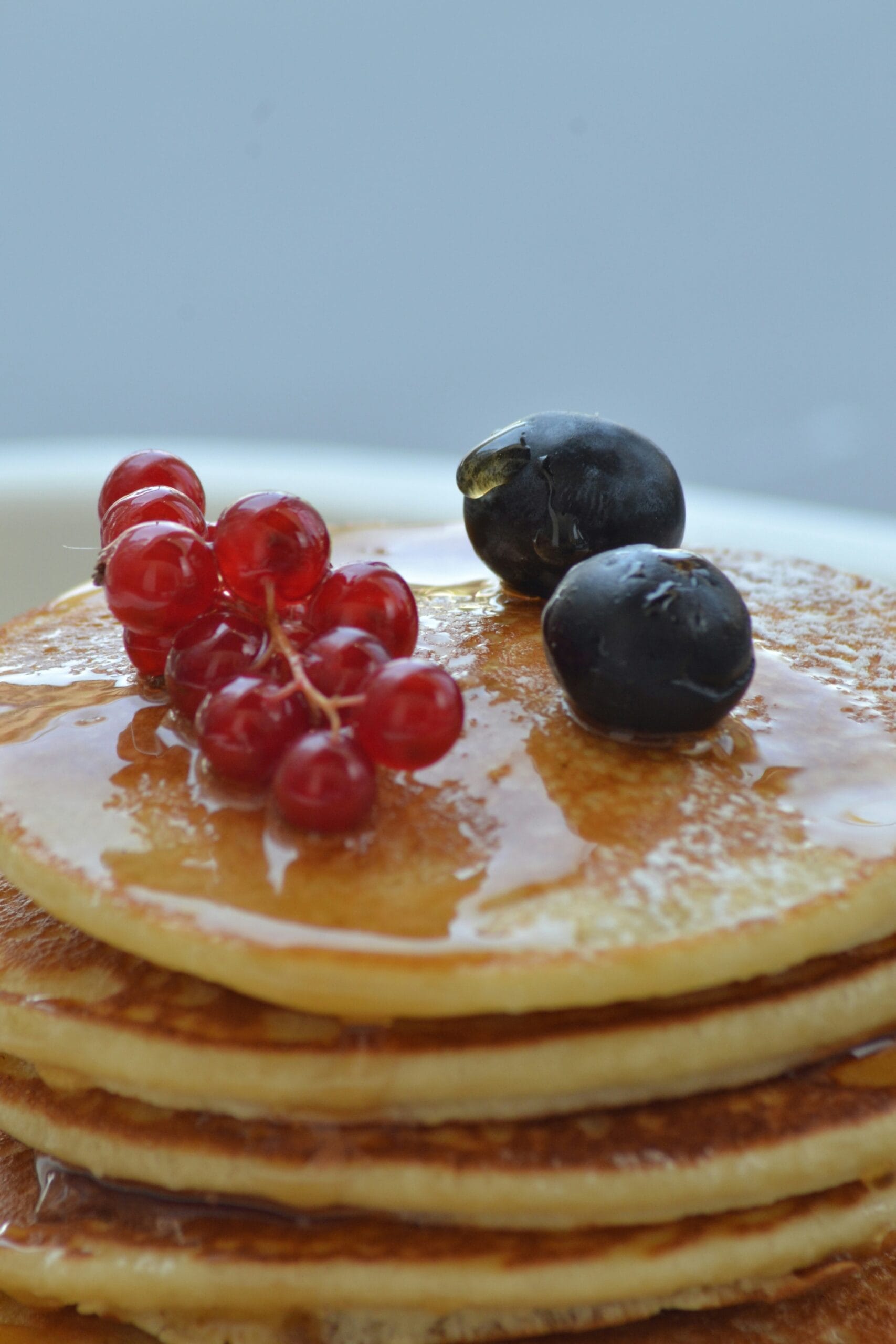
Introduction to Pancakes
Pancakes are a versatile and beloved breakfast staple enjoyed by various cultures worldwide, showcasing delicious and fluffy textures that appeal to many palates. Historically, pancakes can be traced back to ancient civilizations, with references found in Greek and Roman texts, as well as in the culinary traditions of the Middle Ages. These early iterations often included simple ingredients like flour and water, cooked on hot stones or iron plates. Over time, the recipe evolved to incorporate more diverse ingredients, such as milk, eggs, and leavening agents, resulting in the delightful pancakes we enjoy today.
The global popularity of pancakes can be attributed to their adaptability and the numerous variations stemming from different cultures. For instance, the French have crepes, which are thin pancakes often filled with sweet or savory ingredients. Meanwhile, in the United States, fluffy buttermilk pancakes serve as a breakfast favorite, typically accompanied by maple syrup and fresh fruits. Similarly, in Asia, Japanese-style pancakes are renowned for their lightness and airy texture, often enjoyed as a dessert or a snack. Each cultural adaptation highlights unique flavors and presentation styles, enriching the world of pancakes even further.
Moreover, pancakes have remained a cherished breakfast choice due to their ease of preparation and the comfort they provide. Making pancakes at home allows individuals to customize the ingredients based on personal preferences, dietary needs, or seasonal availability. Whether one prefers classic buttermilk pancakes or tries experimental flavors like matcha or pumpkin spice, the process of pancake-making encourages creativity in the kitchen. As simple to whip up as they are satisfying to eat, this delightful dish continues to be a favorite, making it a perfect subject for exploration in one’s own culinary practices.
Ingredients You Will Need
To create the perfect pancakes, a thoughtfully selected list of ingredients is essential. Each component plays a crucial role in achieving softness, flavor, and texture. The primary ingredient to consider is flour, which serves as the base of the batter. All-purpose flour is the most common choice due to its versatility and ability to produce fluffy pancakes. However, whole wheat flour can be incorporated for a healthier alternative, while gluten-free options such as almond or oat flour cater to those with dietary restrictions.
Another key ingredient is the leavening agent, typically baking powder. This component allows the batter to rise, creating the fluffy texture characteristic of pancakes. Make sure to use fresh baking powder for the best results, as its effectiveness diminishes over time. Additionally, a pinch of salt enhances the flavor, balancing the sweetness from other ingredients.
To bind the mixture, eggs are often included. They contribute to the rich taste and provide a satisfying structure. For a vegan alternative, mashed bananas or applesauce serves as an excellent substitute, introducing moisture while maintaining the pancake’s fluffiness.
Milk is another fundamental ingredient that adds moisture and richness to the batter. Whole milk can provide a creamier texture, but for those who prefer alternatives, almond milk, soy milk, or oat milk work well without compromising the taste. Moreover, adding a sweetener, such as sugar or maple syrup, elevates the flavor profile, while vanilla extract introduces a warm aroma that pairs wonderfully with the pancakes.
In summary, by carefully selecting and understanding the function of these ingredients—flour, leavening agent, eggs (or substitutes), milk (or alternatives), and sweeteners—you can create pancakes that are not only delicious but also adaptable to various dietary needs and preferences.
Equipment Required
To create the perfect pancake, having the right kitchen tools and equipment is essential. This not only facilitates a smoother cooking process but also enhances the overall quality of the pancakes produced. Key tools include mixing bowls, measuring cups, a whisk or electric mixer, a non-stick skillet or griddle, and a spatula.
Firstly, mixing bowls are critical for combining the dry and wet ingredients. It is advisable to use a large, sturdy bowl to prevent spills. A set of measuring cups is also necessary for achieving precise quantities of flour, milk, and other ingredients, which directly influences the texture of your pancakes. Accurate measurements are vital in ensuring fluffy pancakes, as even a minor variance can produce suboptimal results.
For mixing ingredients, either a whisk or an electric mixer can be used. A whisk is a traditional tool that offers more control over the mixing process, allowing for gentle incorporation of air into the batter. However, for those pressed for time or seeking convenience, an electric mixer can produce a uniform batter quickly. Regardless of the tool chosen, the goal is to mix until just combined, as over-mixing can lead to dense pancakes.
The next important piece of equipment is a non-stick skillet or griddle. This type of cookware is preferred as it minimizes the chances of sticking, allowing for easy flipping and optimal browning of the pancakes. Ensure the skillet is preheated at the right temperature before pouring in the batter for ideal cooking results. Finally, a spatula is vital for flipping the pancakes once they’ve bubbled on one side, ensuring that they maintain their fluffy integrity.
In summary, equipping your kitchen with the right tools such as mixing bowls, measuring cups, whisks or mixers, a skillet or griddle, and a spatula plays a significant role in the successful crafting of delicious, fluffy pancakes. Each piece of equipment contributes uniquely to achieving the best final product.
Step-by-Step Recipe Instructions
Creating the perfect pancake begins with gathering the essential ingredients. For a basic pancake recipe, you will need 1 cup of all-purpose flour, 2 tablespoons of sugar, 1 tablespoon of baking powder, a pinch of salt, 1 cup of milk, 1 large egg, and 2 tablespoons of melted butter. Begin by combining the dry ingredients in a large mixing bowl. Whisk together the flour, sugar, baking powder, and salt until well incorporated.
Next, in a separate bowl, whisk together the wet ingredients. Combine the milk, egg, and melted butter, ensuring the mixture is homogeneous. Gradually pour this wet mixture into the dry ingredients, stirring gently. It is crucial not to overmix; a few lumps in the batter will contribute to the fluffiness of the pancakes. Allow the batter to rest for about five minutes while you preheat your cooking surface.
Heat a non-stick skillet or griddle over medium heat. It is essential to achieve the right temperature; if the heat is too high, the pancakes may burn before cooking through, and if too low, they may turn out flat. To test the heat, drop a small amount of batter onto the pan; it should sizzle gently. Once hot, pour about 1/4 cup of batter for each pancake into the pan. Cook each pancake until bubbles form on the surface, typically around 2-3 minutes.
Carefully flip the pancake using a spatula and cook for an additional 1-2 minutes until golden brown. Remove from the heat and place on a warm plate. Repeat this process with the remaining batter, adjusting the heat as necessary to ensure even cooking. For an added touch, serve your pancakes with fresh fruits, syrups, or whipped cream, enhancing both flavor and presentation.
Cooking Tips for Perfect Pancakes
Creating the perfect pancake requires attention to detail, particularly when it comes to ingredient ratios. A typical pancake batter consists of flour, baking powder, milk, eggs, and a pinch of salt. Maintaining the correct flour-to-liquid ratio is crucial; too much flour can result in dry pancakes, while too much liquid may yield a runny batter. A general guideline is to use one cup of flour to one cup of milk, adjusting as necessary based on the desired thickness. Incorporating ingredients sequentially—starting with dry ingredients before adding wet ones—can also promote a smoother batter free from lumps.
Recognizing the ideal moment to flip pancakes is another essential skill. Pancakes are ready to be turned when bubbles form on the surface and begin to pop, with the edges looking set but not dry. Waiting too long may result in overcooked pancakes, while flipping too early can lead to undercooked centers. A gentle shake of the pan can also help assess readiness; if the pancake moves freely, it’s time for a flip.
Batch cooking pancakes can be an efficient way to satisfy larger gatherings. Cook multiple pancakes in quick succession, keeping them warm by placing them on a baking sheet in a low-temperature oven, around 200°F. Layering them with parchment paper in between can prevent sticking and ensure they retain their fluffy texture. Additionally, always taste your batter and make adjustments as preferred. For instance, a hint of vanilla or a touch of sugar can elevate the flavor profile. By following these expert tips, you will undoubtedly elevate your pancake-making skills, resulting in golden-brown, fluffy delights that will impress your family and friends.
Creative Toppings and Variations
Enhancing your pancake experience is an enjoyable aspect of pancake preparation that can elevate a simple dish into a memorable meal. The beauty of pancakes lies in their versatility, allowing for a myriad of creative toppings and mix-ins to suit diverse palates. One of the most popular options is the inclusion of fresh fruits such as blueberries, strawberries, and bananas. Adding these fruits not only provides natural sweetness but also infuses a burst of flavor and essential nutrients into each bite.
Nuts also make for an excellent addition, with options ranging from walnuts to pecans, offering a delightful crunch that complements the fluffiness of the pancakes. For those who enjoy a sweeter twist, consider drizzling your pancakes with an array of syrups. Maple syrup remains a classic choice, but flavored syrups such as caramel, berry, or chocolate can bring a new dimension to your dish. Furthermore, whipped cream can be used to enhance the overall aesthetics and taste of pancakes, providing a light and creamy contrast to the warm, fluffy base.
Chocolate chips are another favored mix-in that can be stirred directly into the batter. They melt slightly during cooking, creating pockets of gooey chocolate that are simply irresistible. To explore beyond traditional pancakes, you can experiment with themed variations such as pumpkin spice pancakes in the fall or lemon poppyseed pancakes for a refreshing spring option. By integrating different flavors into the batter, you broaden the pancake experience, ensuring each meal brings something new to the table.
Incorporating these toppings and variations allows for a personalized pancake experience that can be tailored to suit family preferences or special occasions. The potential for creativity in pancake preparation is virtually limitless, making it a delightful endeavor for anyone eager to indulge in this timeless dish.
Common Mistakes to Avoid
When embarking on the journey of making pancakes, there are several common pitfalls that can thwart your efforts, leading to less-than-perfect results. One of the most significant mistakes is over-mixing the batter. While it may seem logical to vigorously stir until all ingredients are perfectly blended, this can lead to dense and chewy pancakes. The key is to mix just until the dry ingredients are incorporated into the wet mixture, achieving a slightly lumpy consistency. This ensures that your pancakes remain fluffy and light.
Another frequent error is using the wrong heat level while cooking. Many novice cooks may either underheat or overheat their griddle or frying pan, resulting in pancakes that are burnt on the outside yet raw on the inside. Ideally, a medium heat setting is recommended. This allows the pancakes to cook evenly, developing a golden brown exterior while remaining soft and airy within. If you encounter uneven cooking, consider adjusting the heat before pouring in your batter for the best pancake experience.
Incorrect ingredient proportions can also derail your pancake-making endeavor. A common miscalculation involves misjudging the amount of flour or liquid, which can result in pancakes that are either too dry or too wet. To prevent this, always measure your ingredients accurately, using measuring cups and spoons specifically designed for dry and liquid ingredients. Additionally, remember that different types of flour absorb liquids differently; for instance, whole wheat flour will require more liquid than all-purpose flour. Taking the extra time to measure properly will undoubtedly enhance the quality of your pancakes.
By being mindful of these common mistakes—over-mixing, heat levels, and ingredient proportions—you will significantly increase your chances of creating the perfect stack of fluffy pancakes.
Healthier Pancake Alternatives
Pancakes are a beloved breakfast staple, but traditional recipes are often high in refined flour and sugar. For those seeking healthier pancake options without compromising on taste, there are several alternatives worth considering. Whole grain pancakes, made from whole wheat flour, provide increased fiber content and essential nutrients compared to their white flour counterparts. This simple switch enhances the nutritional profile, promoting better digestion and sustained energy levels throughout the day.
For individuals with gluten sensitivities or celiac disease, gluten-free pancakes can be an excellent alternative. Ingredients such as almond flour, coconut flour, or a gluten-free all-purpose blend allow for a delicious pancake without the gluten. These flours not only accommodate dietary restrictions but also add unique flavors and nutrition that enrich the pancake experience. Additionally, incorporating ingredients like oats can provide a wholesome flavor and added health benefits.
Vegan pancakes offer another nutritious option by replacing eggs and dairy with plant-based ingredients. Bananas or apple sauce can often serve as effective egg substitutes, providing moisture and natural sweetness. Using almond milk or soy milk can replace dairy milk, ensuring a fluffy texture while keeping the pancakes entirely plant-based. Furthermore, incorporating nutrient-dense toppings, such as fresh fruits, nuts, and seeds, can enhance the flavor and health benefits of pancakes.
To make pancakes more health-conscious, consider reducing added sugars and replacing them with natural sweeteners like honey or maple syrup, or even using pureed fruits for sweetness. Experimenting with spices such as cinnamon or nutmeg can add warmth and flavor without added calories. By choosing healthier alternatives and making mindful substitutions, indulging in pancakes can align with a wholesome diet, allowing everyone to enjoy this classic dish guilt-free.
Conclusion and Final Thoughts
In conclusion, the journey to crafting the perfect pancake is both delightful and rewarding. This ultimate pancake recipe combines simplicity with the promise of fluffy, delicious results that anyone can achieve. Throughout this blog post, we have highlighted the essential ingredients and steps required to create pancakes that not only satisfy the palate but also evoke a sense of nostalgia and comfort. By blending key elements such as the right proportions of flour, milk, and eggs, along with the crucial technique of not over-mixing, home cooks can produce restaurant-quality pancakes right in their kitchens.
Pancakes are not merely a breakfast item; they serve as a canvas for creativity and personal expression. As you prepare your pancakes, consider exploring variations by adding fruits, nuts, or flavored extracts to the batter. Each addition can create a unique taste experience, allowing you to tailor the pancakes to suit different preferences. Furthermore, the joy of sharing these pancakes with family and friends can lead to cherished memories and traditions that celebrate the act of cooking together.
We encourage you to experiment with this recipe, adjusting ingredients and toppings according to your taste. Whether you prefer traditional maple syrup, fresh berries, or a dollop of whipped cream, the possibilities are virtually endless. By sharing your pancake creations with fellow enthusiasts, you contribute to a vibrant community where culinary ideas flourish. Enthusiastic pancake lovers can learn from each other, inspiring more adventurous recipes and techniques.
Ultimately, making pancakes at home is about more than just the food; it is an experience to be savored. Embrace the process, celebrate your successes, and relish every bite. Your next pancake breakfast awaits!


